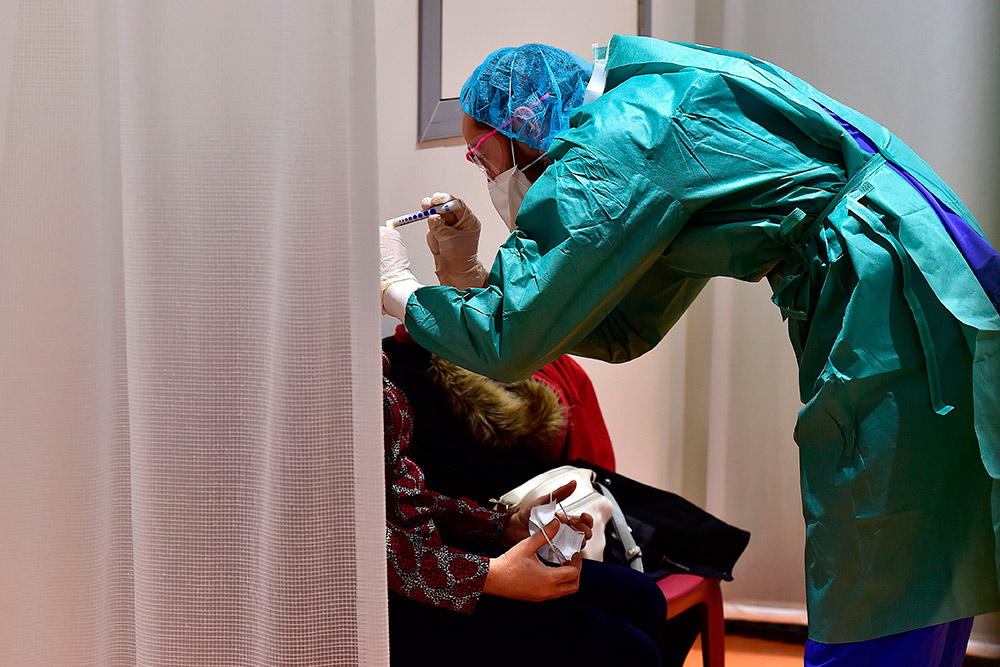大多數(shù)不幸感染新冠病毒的人,,病毒只是停留在他們的鼻腔和喉嚨,只會(huì)引起咳嗽等癥狀,。然而,,當(dāng)病毒到達(dá)肺部的時(shí)候,情況就開(kāi)始變得危險(xiǎn)了,。
七分之一的患者會(huì)出現(xiàn)呼吸困難和其他嚴(yán)重并發(fā)癥,,6%的患者會(huì)發(fā)展為危重癥患者。根據(jù)上個(gè)月發(fā)布的《中國(guó)—世界衛(wèi)生組織新型冠狀病毒肺炎聯(lián)合考察報(bào)告》,,這些患者通?;加泻粑ソ吆推渌匾鞴偎ソ撸械倪€會(huì)出現(xiàn)膿毒性休克,。
世衛(wèi)組織總干事高級(jí)顧問(wèn)布魯斯·艾爾沃德表示,,從輕中癥發(fā)展到重癥可能會(huì) “非常非常快”,。艾爾沃德是中國(guó)—世界衛(wèi)生組織新型冠狀病毒肺炎聯(lián)合考察組外方組長(zhǎng),,在中國(guó)考察了5.6萬(wàn)例病例的數(shù)據(jù)。自去年12月武漢首次出現(xiàn)新冠肺炎病例以來(lái),新冠肺炎已經(jīng)導(dǎo)致超過(guò)4000人死亡,。了解這種疾病的發(fā)病過(guò)程以及識(shí)別高危人群,,對(duì)于更好地應(yīng)對(duì)這種全球性傳染病有著至關(guān)重要的作用。
大約10%到15%的輕中癥患者會(huì)發(fā)展為重癥患者,,而15%到20%的重癥患者會(huì)發(fā)展為危重癥患者,。高危患者包括60歲及以上的患者以及患有高血壓,、糖尿病和心血管疾病等既有疾病的患者,。
杰弗里·K·陶本伯格對(duì)西班牙流感患者的感染情況進(jìn)行過(guò)研究,20多年前還從美國(guó)阿拉斯加西北部的永久凍土中挖掘出一具西班牙流感患者的尸體用以研究,。陶本伯格稱:“從臨床表現(xiàn)來(lái)看,,這種疾病的感染模式與流感沒(méi)有什么不同?!?/p>
新冠肺炎(Covid-19)很可能是通過(guò)感染者咳嗽,、打噴嚏或呼吸時(shí)排出的攜帶病毒的飛沫來(lái)傳播的。
最先受感染的一般是鼻部,。陶本伯格是美國(guó)國(guó)家過(guò)敏和傳染病研究所病毒發(fā)病和進(jìn)化機(jī)理部門(mén)的負(fù)責(zé)人,,該研究所位于馬里蘭州貝塞斯達(dá)。他表示,,新冠病毒一旦進(jìn)入人體,就會(huì)入侵保護(hù)著呼吸道的上皮細(xì)胞,。如果病毒被限制在上呼吸道中,,癥狀通常不會(huì)太嚴(yán)重。
但如果病毒沿著氣管進(jìn)入呼吸樹(shù)和肺組織的外圍分支,,疾病就可能發(fā)展到更嚴(yán)重的階段,。這是因?yàn)椴《疽l(fā)的肺炎會(huì)對(duì)人體造成直接損害,而人體的免疫反應(yīng)又會(huì)造成二次損害,。
陶本伯格說(shuō):“一旦發(fā)生肺部損傷,,人體就會(huì)立即嘗試修復(fù)?!?各種白細(xì)胞是最先作出反應(yīng)的,,它們會(huì)消滅病原體,并參與修復(fù)受損的人體組織,?!巴ǔG闆r下,如果進(jìn)展順利,,短短幾天內(nèi)就能清除感染,。”
陶本伯格指出,,在一些更嚴(yán)重的新冠肺炎感染病例中,,免疫系統(tǒng)的反應(yīng)可能過(guò)于強(qiáng)烈,,導(dǎo)致不僅被病毒感染的細(xì)胞被消滅,健康的人體組織也同樣被損壞,。氣管或支氣管的上皮如果受損,,就可能會(huì)喪失一些分泌黏液的保護(hù)性細(xì)胞,或者喪失將塵垢和呼吸道分泌物清掃出肺部的纖毛,。
陶本伯格表示:“這樣,,人體就無(wú)法阻擋病原體進(jìn)入下呼吸道?!币虼?,肺部很容易繼發(fā)侵襲性細(xì)菌感染。平時(shí)藏匿在鼻腔和喉嚨之中的病菌,,以及醫(yī)院里滋生的耐藥性細(xì)菌——特別是在呼吸機(jī)管路和面罩內(nèi)潮濕的空氣中,,更容易有細(xì)菌滋生——都可能會(huì)引發(fā)感染。

繼發(fā)性細(xì)菌感染會(huì)對(duì)患者構(gòu)成特別嚴(yán)重的威脅,,因?yàn)樗鼈兛赡軙?huì)殺死呼吸道干細(xì)胞,而這些干細(xì)胞對(duì)于人體組織恢復(fù)活力至關(guān)重要,。陶本伯格表示,,沒(méi)有了這些呼吸道干細(xì)胞,“就無(wú)法修復(fù)肺部損傷,?!狈尾渴軗p會(huì)導(dǎo)致人體重要器官缺氧,進(jìn)而對(duì)腎臟,、肝臟,、大腦和心臟造成損害。
美國(guó)國(guó)家過(guò)敏和傳染病研究所的所長(zhǎng)高級(jí)科學(xué)顧問(wèn)大衛(wèi)·莫朗說(shuō):“當(dāng)人體遭受非常嚴(yán)重的感染時(shí),,所有器官都會(huì)開(kāi)始接連崩潰,。一旦過(guò)了那個(gè)臨界點(diǎn),一切便都開(kāi)始走下坡路,。到了某個(gè)時(shí)候,,就再也無(wú)法挽回了?!?/p>
美國(guó)艾奧瓦城的艾奧瓦大學(xué)(University Of Iowa)微生物學(xué)和免疫學(xué)教授斯坦利·珀?duì)柭芯抗跔畈《疽延?8年之久,。他認(rèn)為,這個(gè)臨界點(diǎn)在老年人身上可能也會(huì)更早出現(xiàn),,就像小鼠實(shí)驗(yàn)中的老年小鼠一樣,。
然而,即便是原本身體健康的年輕人,也已經(jīng)有死于新冠肺炎的病例,。武漢一位34歲的眼科醫(yī)生李文亮接受了抗體,、抗病毒藥物、抗生素和吸氧治療,,還將血液引出體外再經(jīng)人工肺泵回體內(nèi),,但最終還是于上月不幸離世。
陶本伯格表示,,某些人的基因特征可能是他們更容易受病毒侵襲的原因,,具體原因可能是他們的呼吸道上皮細(xì)胞中有更多容易與病毒結(jié)合的特定形狀的蛋白受體。另外,,某些人可能有輕微的免疫缺陷或基礎(chǔ)疾病相關(guān)的其他宿主因素,。(財(cái)富中文網(wǎng))
譯者:溫丹萍
大多數(shù)不幸感染新冠病毒的人,病毒只是停留在他們的鼻腔和喉嚨,,只會(huì)引起咳嗽等癥狀,。然而,當(dāng)病毒到達(dá)肺部的時(shí)候,,情況就開(kāi)始變得危險(xiǎn)了,。
七分之一的患者會(huì)出現(xiàn)呼吸困難和其他嚴(yán)重并發(fā)癥,6%的患者會(huì)發(fā)展為危重癥患者,。根據(jù)上個(gè)月發(fā)布的《中國(guó)—世界衛(wèi)生組織新型冠狀病毒肺炎聯(lián)合考察報(bào)告》,,這些患者通常患有呼吸衰竭和其他重要器官衰竭,,有的還會(huì)出現(xiàn)膿毒性休克,。
世衛(wèi)組織總干事高級(jí)顧問(wèn)布魯斯·艾爾沃德表示,從輕中癥發(fā)展到重癥可能會(huì) “非常非??臁薄0瑺栁值率侵袊?guó)—世界衛(wèi)生組織新型冠狀病毒肺炎聯(lián)合考察組外方組長(zhǎng),,在中國(guó)考察了5.6萬(wàn)例病例的數(shù)據(jù),。自去年12月武漢首次出現(xiàn)新冠肺炎病例以來(lái),新冠肺炎已經(jīng)導(dǎo)致超過(guò)4000人死亡,。了解這種疾病的發(fā)病過(guò)程以及識(shí)別高危人群,,對(duì)于更好地應(yīng)對(duì)這種全球性傳染病有著至關(guān)重要的作用。
大約10%到15%的輕中癥患者會(huì)發(fā)展為重癥患者,,而15%到20%的重癥患者會(huì)發(fā)展為危重癥患者,。高危患者包括60歲及以上的患者以及患有高血壓,、糖尿病和心血管疾病等既有疾病的患者,。
杰弗里·K·陶本伯格對(duì)西班牙流感患者的感染情況進(jìn)行過(guò)研究,20多年前還從美國(guó)阿拉斯加西北部的永久凍土中挖掘出一具西班牙流感患者的尸體用以研究。陶本伯格稱:“從臨床表現(xiàn)來(lái)看,,這種疾病的感染模式與流感沒(méi)有什么不同,。”
新冠肺炎(Covid-19)很可能是通過(guò)感染者咳嗽,、打噴嚏或呼吸時(shí)排出的攜帶病毒的飛沫來(lái)傳播的,。
最先受感染的一般是鼻部。陶本伯格是美國(guó)國(guó)家過(guò)敏和傳染病研究所病毒發(fā)病和進(jìn)化機(jī)理部門(mén)的負(fù)責(zé)人,,該研究所位于馬里蘭州貝塞斯達(dá),。他表示,新冠病毒一旦進(jìn)入人體,,就會(huì)入侵保護(hù)著呼吸道的上皮細(xì)胞,。如果病毒被限制在上呼吸道中,癥狀通常不會(huì)太嚴(yán)重,。
但如果病毒沿著氣管進(jìn)入呼吸樹(shù)和肺組織的外圍分支,,疾病就可能發(fā)展到更嚴(yán)重的階段。這是因?yàn)椴《疽l(fā)的肺炎會(huì)對(duì)人體造成直接損害,,而人體的免疫反應(yīng)又會(huì)造成二次損害,。
陶本伯格說(shuō):“一旦發(fā)生肺部損傷,人體就會(huì)立即嘗試修復(fù),?!?各種白細(xì)胞是最先作出反應(yīng)的,它們會(huì)消滅病原體,,并參與修復(fù)受損的人體組織,。“通常情況下,,如果進(jìn)展順利,,短短幾天內(nèi)就能清除感染?!?/p>
陶本伯格指出,,在一些更嚴(yán)重的新冠肺炎感染病例中,免疫系統(tǒng)的反應(yīng)可能過(guò)于強(qiáng)烈,,導(dǎo)致不僅被病毒感染的細(xì)胞被消滅,,健康的人體組織也同樣被損壞。氣管或支氣管的上皮如果受損,,就可能會(huì)喪失一些分泌黏液的保護(hù)性細(xì)胞,,或者喪失將塵垢和呼吸道分泌物清掃出肺部的纖毛。
陶本伯格表示:“這樣,,人體就無(wú)法阻擋病原體進(jìn)入下呼吸道,?!币虼耍尾亢苋菀桌^發(fā)侵襲性細(xì)菌感染,。平時(shí)藏匿在鼻腔和喉嚨之中的病菌,,以及醫(yī)院里滋生的耐藥性細(xì)菌——特別是在呼吸機(jī)管路和面罩內(nèi)潮濕的空氣中,更容易有細(xì)菌滋生——都可能會(huì)引發(fā)感染,。
繼發(fā)性細(xì)菌感染會(huì)對(duì)患者構(gòu)成特別嚴(yán)重的威脅,,因?yàn)樗鼈兛赡軙?huì)殺死呼吸道干細(xì)胞,而這些干細(xì)胞對(duì)于人體組織恢復(fù)活力至關(guān)重要,。陶本伯格表示,,沒(méi)有了這些呼吸道干細(xì)胞,“就無(wú)法修復(fù)肺部損傷,?!狈尾渴軗p會(huì)導(dǎo)致人體重要器官缺氧,進(jìn)而對(duì)腎臟,、肝臟,、大腦和心臟造成損害。
美國(guó)國(guó)家過(guò)敏和傳染病研究所的所長(zhǎng)高級(jí)科學(xué)顧問(wèn)大衛(wèi)·莫朗說(shuō):“當(dāng)人體遭受非常嚴(yán)重的感染時(shí),,所有器官都會(huì)開(kāi)始接連崩潰,。一旦過(guò)了那個(gè)臨界點(diǎn),一切便都開(kāi)始走下坡路,。到了某個(gè)時(shí)候,,就再也無(wú)法挽回了?!?/p>
美國(guó)艾奧瓦城的艾奧瓦大學(xué)(University Of Iowa)微生物學(xué)和免疫學(xué)教授斯坦利·珀?duì)柭芯抗跔畈《疽延?8年之久,。他認(rèn)為,這個(gè)臨界點(diǎn)在老年人身上可能也會(huì)更早出現(xiàn),,就像小鼠實(shí)驗(yàn)中的老年小鼠一樣,。
然而,即便是原本身體健康的年輕人,,也已經(jīng)有死于新冠肺炎的病例,。武漢一位34歲的眼科醫(yī)生李文亮接受了抗體、抗病毒藥物,、抗生素和吸氧治療,還將血液引出體外再經(jīng)人工肺泵回體內(nèi),,但最終還是于上月不幸離世,。
陶本伯格表示,某些人的基因特征可能是他們更容易受病毒侵襲的原因,,具體原因可能是他們的呼吸道上皮細(xì)胞中有更多容易與病毒結(jié)合的特定形狀的蛋白受體,。另外,,某些人可能有輕微的免疫缺陷或基礎(chǔ)疾病相關(guān)的其他宿主因素。(財(cái)富中文網(wǎng))
譯者:溫丹萍
The new coronavirus causes little more than a cough if it stays in the nose and throat, which it does for the majority of people unlucky enough to be infected. Danger starts when it reaches the lungs.
One in seven patients develops difficulty breathing and other severe complications, while 6% become critical. These patients typically suffer failure of the respiratory and other vital systems, and sometimes develop septic shock, according to a report by last month’s joint World Health Organization-China mission.
The progression from mild or moderate to severe can occur “very, very quickly,” said Bruce Aylward, a WHO assistant director-general who co-led a mission in China that reviewed data from 56,000 cases. Understanding the course of the disease and identifying individuals at greatest risk are critical for optimizing care for a global contagion that’s killed more than 3,700 people since emerging in central China in December.
About 10-15% of mild-to-moderate patients progress to severe and of those, 15-20% progress to critical. Patients at highest risk include people age 60 and older and those with pre-existing conditions such as hypertension, diabetes and cardiovascular disease.
“The clinical picture suggests a pattern of disease that’s not dissimilar to what we might see in influenza,” said Jeffery K. Taubenberger, who studied the infection in Spanish flu victims, including one exhumed more than 20 years ago from permafrost in northwestern Alaska.
Covid-19 most likely spreads via contact with virus-laden droplets expelled from an infected person’s cough, sneeze or breath.
Infection generally starts in the nose. Once inside the body, the coronavirus invades the epithelial cells that line and protect the respiratory tract, said Taubenberger, who heads the viral pathogenesis and evolution section of the National Institute of Allergy and Infectious Diseases in Bethesda, Maryland. If it’s contained in the upper airway, it usually results in a less severe disease.
But if the virus treks down the windpipe to the peripheral branches of the respiratory tree and lung tissue, it can trigger a more severe phase of the disease. That’s due to the pneumonia-causing damage inflicted directly by the virus plus secondary damage caused by the body’s immune response to the infection.
“Your body is immediately trying to repair the damage in the lung as soon as it’s happening,” Taubenberger said. Various white blood cells that consume pathogens and help heal damaged tissue act as first-responders. “Normally, if this goes well, you can clear up your infection in just a few days.”
In some more-severe coronavirus infections, the body’s effort to heal itself may be too robust, leading to the destruction of not just virus-infected cells, but healthy tissue, Taubenberger said. Damage to the epithelium lining the trachea and bronchi can result in the loss of protective mucus-producing cells as well as the tiny hairs, or cilia, that sweep dirt and respiratory secretions out of the lungs.
“You have no ability to keep stuff out of the lower respiratory tract,” Taubenberger said. As a result, the lungs are vulnerable to an invasive secondary bacterial infection. Potential culprits include the germs normally harbored in the nose and throat, and the antibiotic-resistant bacteria that thrive in hospitals, especially the moist environments of mechanical ventilators.
Secondary bacterial infections represent an especially pernicious threat because they can kill critical respiratory tract stem cells that enable tissue to rejuvenate. Without them, “you just can’t physically repair your lungs,” Taubenberger said. Damaged lungs can starve vital organs of oxygen, impairing the kidneys, liver, brain and heart.
“When you get a bad, overwhelming infection, everything starts to fall apart in a cascade,” said David Morens, senior scientific adviser to the director of the National Institute of Allergy and Infectious Diseases. “You pass the tipping point where everything is going downhill and, at some point, you can’t get it back.”
That tipping point probably also occurs earlier in older people, as it does in experiments with older mice, said Stanley Perlman, a professor of microbiology and immunology at the University of Iowa in Iowa City, who has studied coronaviruses for 38 years.
Still, even healthy younger adults have succumbed to the illness. Li Wenliang, the 34-year-old ophthalmologist who was one of the first to warn about the coronavirus in Wuhan, died last month after receiving antibodies, antivirals, antibiotics, oxygen and having his blood pumped through an artificial lung.
Some people may be more genetically susceptible, possibly because they have a greater abundance of the distinctly shaped protein receptors in their respiratory epithelial cells that the virus targets, Taubenberger said. It’s also possible certain individuals have some minor immunodeficiency or other host factors that relate to underlying illnesses.






